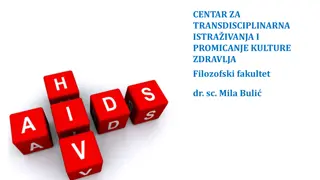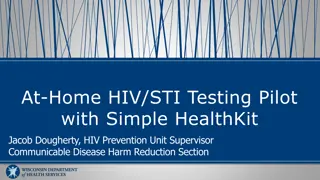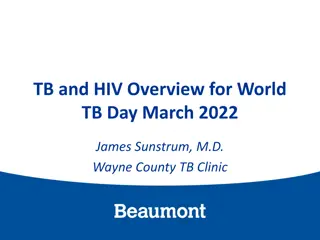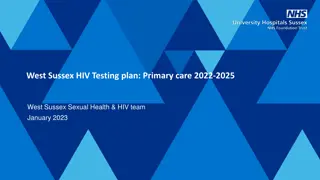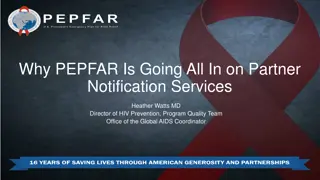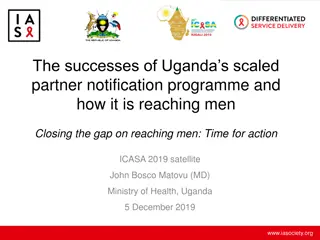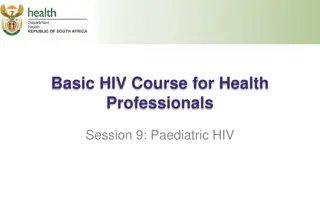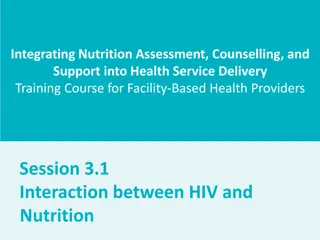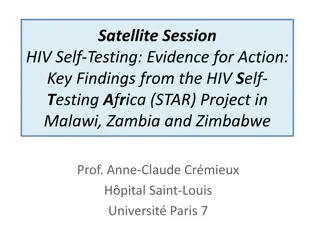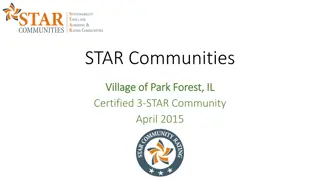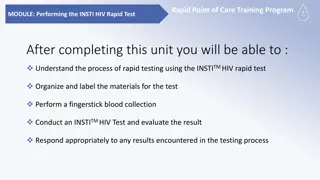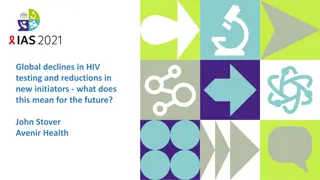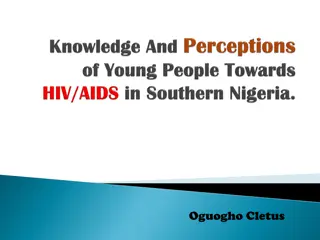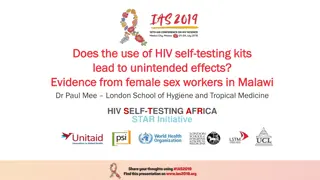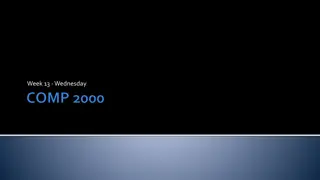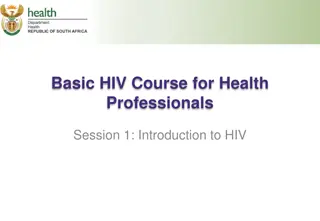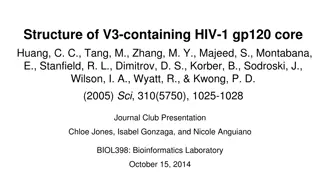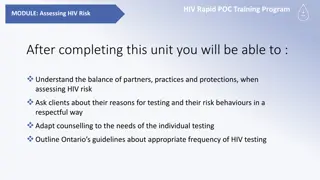Innovations in HIV Self-Testing: The STAR III Program in Nigeria
Explore the STAR III program in Nigeria, which aims to catalyze HIV self-testing through innovative service delivery models in both public and private sectors. Learn about the program's impact on HIV prevention, treatment, and linkage services, as well as its efforts in policy, planning, and capacity-building. Discover how STAR III is creating an enabling environment for HIV self-testing scale-up in Nigeria.
Download Presentation

Please find below an Image/Link to download the presentation.
The content on the website is provided AS IS for your information and personal use only. It may not be sold, licensed, or shared on other websites without obtaining consent from the author.If you encounter any issues during the download, it is possible that the publisher has removed the file from their server.
You are allowed to download the files provided on this website for personal or commercial use, subject to the condition that they are used lawfully. All files are the property of their respective owners.
The content on the website is provided AS IS for your information and personal use only. It may not be sold, licensed, or shared on other websites without obtaining consent from the author.
E N D
Presentation Transcript
Conflict of interest disclosure I have no relevant financial relationships with ineligible companies to disclose. 29 July 2 August Montreal & virtual aids2022.org #AIDS2022
aids2022.org #AIDS2022 29 July 2 August Montreal & virtual Innovative differentiation: How best to deliver HIV testing, treatment, and prevention services How efficient are HIV self-testing models? A comparison of community, facility, one-stop-shop, and pharmacy retail distribution models in Nigeria Victor Adepoju, Jhpiego Nigeria
HIV in Nigeria 1.7 million people living with HIV (PLHIV) 1.3% HIV prevalence (ages 15 49) 0.61/1,000 HIV incidence (ages 15 49) 90% of PLHIV know their status 86% of PLHIV are receiving antiretroviral therapy (ART) 72% of PLHIV have suppressed viral loads Source: UNAIDS (2020) 29 July 2 August Montreal & virtual aids2022.org #AIDS2022
STAR III Nigeria STAR III is the extension of a Unitaid-funded multi-country HIV self-testing (HIVST) initiative intended to catalyze the market for HIVST. Creating an enabling environment for HIVST scale-up in Nigeria Introducing innovative HIVST service delivery modelsin the public and private sectors to increase uptake and linkage to HIV prevention and treatment services Generating evidence for decision-making 29 July 2 August Montreal & virtual aids2022.org #AIDS2022
STAR III Nigeria Program commenced May 2020 Areas of support: policy and planning; technical capacity-building; demand creation and advocacy; catalytic distribution, laboratory and product registration; supplychain; and transition to government, donor-funded programs, and local partners Provision of 213,350 oral fluid and 95,000 blood-based HIVST kits STAR-supported pharmacy, Lagos Photo credit: Jhpiego Distribution through 15 implementing partners across 12 states 29 July 2 August Montreal & virtual aids2022.org #AIDS2022
Nigeria HIVST Distribution Models STAR provided technical support to the Federal Ministry of Health/National AIDS & STIs Control Programme in determination of HIVST distribution models fit to the Nigerian context. Key populations (KP) one-stop shops (OSS) Facility Pharmacy Community Community pharmacies and patent and proprietary medicine vendors Primary and secondary distribution via various health care services Reaching men, key populations, adolescents and young people, orphans, and vulnerable children in hotspots Integration of HIVST distribution within services offered in peer-led key populations one-stop shops Start: November 2021 Start: January 2021 Start: January 2021 Start: August 2021 29 July 2 August Montreal & virtual aids2022.org #AIDS2022
156,067 HIVST kits were distributed; largest models were facility (43%) and community (38%) 80,000 67,283 70,000 59,532 60,000 50,000 40,000 30,000 23,625 20,000 5,627 10,000 0 Facility KP-OSS Community Pharmacy 29 July 2 August Montreal & virtual aids2022.org #AIDS2022
Community distribution models reached more men of all ages compared to other models Facility (n=67,283) KP-OSS (n=23,625) 7,000 5,000 6,215 6,000 4,000 4,010 5,600 5,597 3,698 5,215 5,000 5,030 4,664 3,213 3,113 3,000 4,140 4,000 2,718 3,712 3,701 3,047 3,000 2,000 1,763 2,436 2,290 2,159 2,000 1,9061,620 1,250 1,247 1,163 1,839 1,817 1,000 1,619 955 902 669 1,154 591 1,000 1,025 448 176 143 28 0 21 50+ 0 1 - 4 5 - 9 10-14 15 - 1920 - 2425 - 2930 - 3435 - 3940 - 4445 - 49 1 - 4 5 - 9 10-14 15 - 19 20 - 24 25 - 29 30 - 34 35 - 39 40 - 44 45 - 49 50+ Male Female Male Female Community (n=59,532) Pharmacy (n=5,627) 800 9,000 704 700 8,108 8,000 669 600 601 7,000 6,398 500 6,000 494 456 473 5,501 5,290 5,000 5,012 400 4,770 355 4,000 300 294 3,439 237 179 3,064 3,000 230 2,771 200 2,761 177 158 116 2,039 2,000 139 117 1,723 1,616 1,553 100 101 1,440 1,098 1,000 45 805 31 20 705 19 12 637 0 429 192 181 0 1 - 4 5 - 9 10-14 15 - 19 20 - 24 25 - 29 30 - 34 35 - 39 40 - 44 45 - 49 50+ 1 - 4 5 - 9 10-14 15 - 19 20 - 24 25 - 29 30 - 34 35 - 39 40 - 44 45 - 49 Male Female 50+ Male Female 29 July 2 August Montreal & virtual aids2022.org #AIDS2022
Outcome reporting rates > 97% for all models of distribution 80,000 70,000 98.0% 99.8% 60,000 50,000 40,000 30,000 97.0% 20,000 98.5% 10,000 0 Facility KP-OSS Community Pharmacy Distributed HIVST kits Reported HIVST results 29 July 2 August Montreal & virtual aids2022.org #AIDS2022
Of those who received one of the 156,067 kits distributed, 3,670 were confirmed HIV-positive and 99% were initiated on ART One-stop shops have the highest yield (5%) followed by facilities (3%) Pharmacies have lower confirmation and linkage KP-OSS 23,625 80,000 120% 25,000 120% Facility 22,900 67,283 66,178 70,000 100% 100% 20,000 96.9% 60,000 99.9% 99.7% 99.7% 99.1% 99.0% 98.1% 98.4% 80% 80% 50,000 15,000 40,000 60% 60% 10,000 30,000 40% 40% 5.0% 3.0% 20,000 5,000 20% 20% 1,155 1,151 1,147 1,146 10,000 2,011 1,972 1,952 1,934 0 0% 0 0% HIVST Kits Distributed Reported HIVST Results HIV Reactive Attended Confirmatory HTS Confirmed HIV Positive Initiated on ART HIVST Kits Distributed Reported HIVST Results HIV Reactive Attended Confirmatory HTS Confirmed HIV Positive Initiated on ART Community 70,000 120% Pharmacy 5,627 6,000 120% 5,541 59,532 59,440 60,000 100% 5,000 100% 99.8% 98.5% 50,000 98.5% 80% 91.9% 4,000 80% 90.5% 40,000 60% 75.0% 3,000 60% 71.8% 30,000 40% 2,000 40% 20,000 1.1% 1.6% 43.3% 20% 10,000 1,000 20% 653 591 543 535 90 39 28 21 0 0% 0 0% HIVST Kits Distributed Reported HIVST HIV Reactive Attended Confirmatory HTS Confirmed HIV Positive Initiated on ART HIVST Kits Distributed Reported HIVST Results HIV Reactive Attended Confirmatory HTS Confirmed HIV Positive Initiated on ART 29 July 2 August Montreal & virtual Results aids2022.org #AIDS2022
Conclusions HIVST implementation is feasible across diverse settings, populations, and ages in Nigeria. The positivity rate and performance across the clinical cascade was optimized through one-stop shops serving key populations. Achieving a high return of results is possible across all models, enabling programs to support and link clients to prevention and treatment based on outcomes. Trends warranting further exploration: Low positivity and test concordance in community and pharmacy models Low linkage to confirmatory testing and ART in pharmacy models More programmatic experience and research is needed to fully understand the potential of each model as the Nigerian program advances. 29 July 2 August Montreal & virtual aids2022.org #AIDS2022
Acknowledgments The authors wish to thank Unitaid; Population Services International and the STAR consortium; the Nigeria Federal Ministry of Health, National AIDS and STD Control Program, National Agency for the Control of AIDS, Medical Laboratory Science Council of Nigeria, and the National Agency for Food and Drug Administration and Control; collaborators in the World Health Organization, Global Fund to Fight AIDS, Tuberculosis and Malaria, Children s Investment Fund Foundation, U.S. government agencies and partners implementing the U.S. President s Emergency Plan for AIDS Relief, AIDS Healthcare Foundation, Clinton Health Access Initiative; civil society and community partners; and HIVST clients, partners, and families. 29 July 2 August Montreal & virtual aids2022.org #AIDS2022



